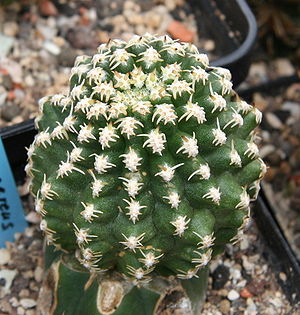Pygmaeocereus bieblii
| Pygmaeocereus bieblii | ||||||||||||
|---|---|---|---|---|---|---|---|---|---|---|---|---|

Pygmaeocereus bieblii |
||||||||||||
| Systematics | ||||||||||||
|
||||||||||||
| Scientific name | ||||||||||||
| Pygmaeocereus bieblii | ||||||||||||
| Diers |
Pygmaeocereus bieblii is a species of plant in the genus Pygmaeocereus from the cactus family(Cactaceae). The epithet of the species honors the German cactus collector Wolfgang Biebl.
description
Pygmaeocereus bieblii grows individually with spherical green shoots up to 5 centimeters in diameter that barely protrude from the ground . The 10 to 25 hardly recognizable ribs are divided into wart-like bumps . The single central spine , which is 2 to 4 millimeters long and 1 millimeter in diameter, can also be missing. The 3 to 10 comb-shaped radial spines are white to dark yellow and 1 to 1.5 millimeters long.
The broad, funnel-shaped, white flowers are 6 to 7 inches long and 4.5 to 6 inches in diameter. Your flower tube is long and slender. The 6 to 10 millimeter long fruits are greenish red to brownish.
Distribution, systematics and endangerment
Pygmaeocereus bieblii is common in the Peruvian region of Ancash, northwest of Huaraz, at altitudes of 600 to 1800 meters.
It was first described in 1995 by Lothar Diers .
In the Red List of Threatened Species of IUCN is the species as " Endangered (EN) ," d. H. listed as endangered.
proof
literature
- Edward F. Anderson : The Great Cactus Lexicon . Eugen Ulmer KG, Stuttgart 2005, ISBN 3-8001-4573-1 , p. 556 .
Individual evidence
- ↑ Cacti and other succulents . Volume 46, Number 11, 1995, pp. 256-260.
- ↑ Pygmaeocereus bieblii in the Red List of Threatened Species of the IUCN 2013.2. Posted by: Ostalaza, C. & Cáceres, F., 2013. Retrieved April 20, 2014.